Star Formation & Galaxies | General Awareness - Bank Exams PDF Download
Star Formation in Galaxies
- Stars are born within the clouds of dust and gas scattered throughout most galaxies.
- Turbulence deep within these clouds gives rise to knots with sufficient mass that the gas and dust can begin to collapse under its own gravitational attraction.
- As the cloud collapses, the material at the center begins to heat up. Known as a protostar, it is this hot core that one day becomes a star.
- Not all of this material ends up as part of a star — the remaining dust can become planets, asteroids, or comets or may remain as dust.
- Stars are fueled by the nuclear fusion of hydrogen to form helium deep in their interiors. The outflow of energy from the central regions of the star provides the pressure necessary to keep the star from collapsing under its own weight, and the energy by which it shines.
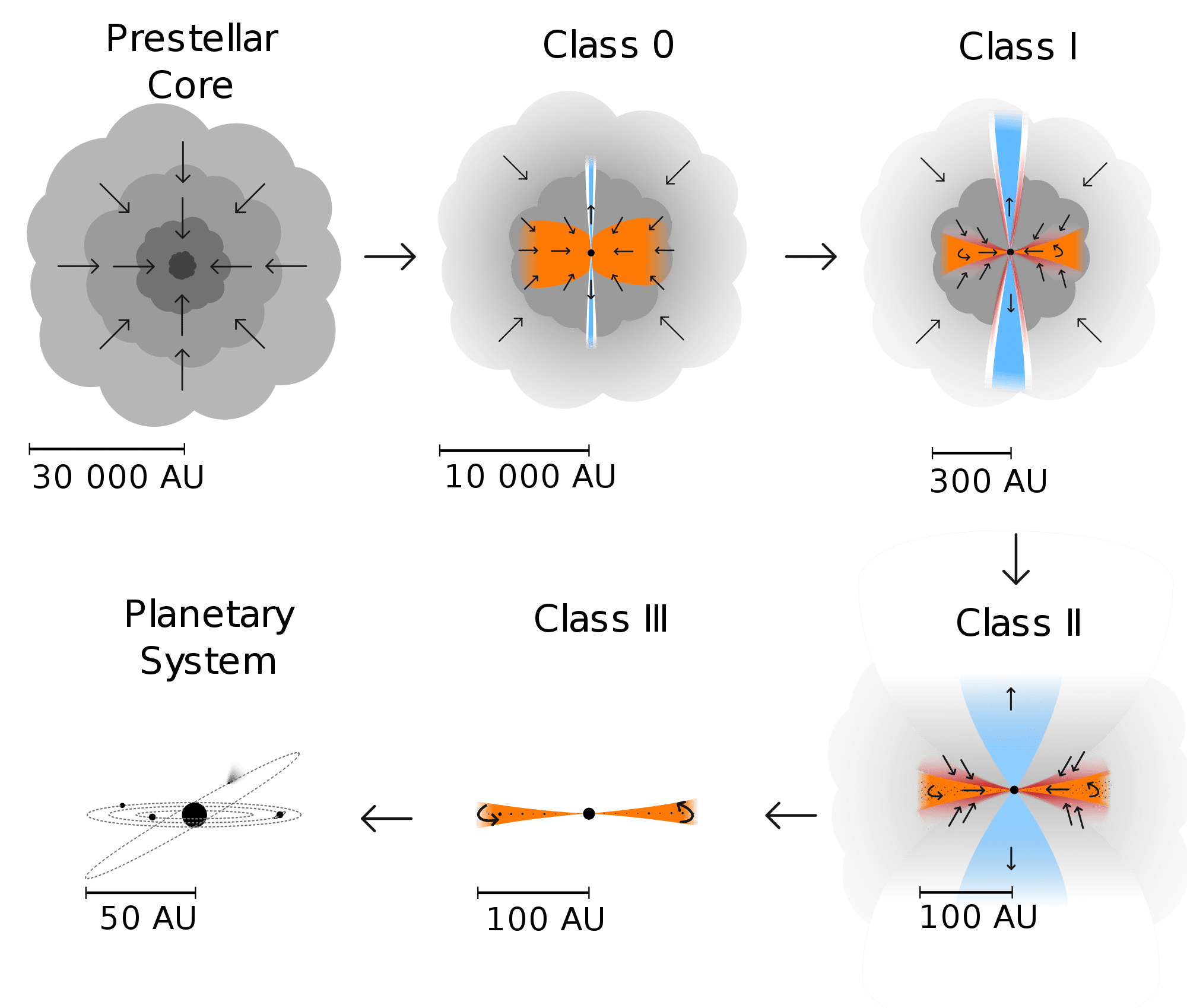
The above illustration shows the six steps of star formation for Sun-like stars.
- The process starts on (A), where gas and dust in the space between stars (also called the InterStellar medium, ISM) collapse into a dense ball of gas called a prestellar core (B) that eventually will become the sun.
- During the collapse, a disk (C) forms around the core, while two jets are emitted at the poles.
- At some point, the star stops growing, but gas still falls onto the disk (D). After a few million years this process also halts. The star is now born (E), while the planets are being formed from the left-over material, which will eventually become a solar system (F).
- A solar system typically lives 10 billion years after the formation process.
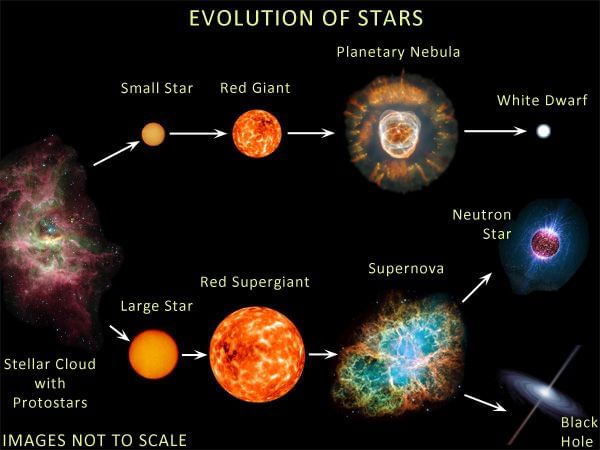
A nebula is a cloud of gas (mostly hydrogen and helium) and dust in space.
Nebulae are the birthplaces of stars.
Protostar- A Protostar looks like a star, but its core is not yet hot enough for nuclear fusion to take place (nuclear fusion: the fusion of 2 hydrogen atoms into a helium atom with the liberation of a huge amount of energy. Nuclear fusion occurs only when the initial temperatures are very high – a few million degree Celsius. That is why it is hard to achieve and control).
- The luminosity comes exclusively from the heating of the Protostar as it contracts (because of gravity).
- Protostars are usually surrounded by dust, which blocks the light that they emit, so they are difficult to observe in the visible spectrum.
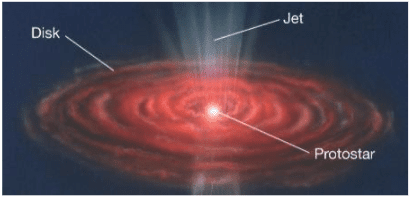
- A very young, lightweight star, less than 10 million years old, that it still undergoing gravitational contraction; it represents an intermediate stage between a Protostar and a low-mass main sequence star like the Sun.
Main sequence stars
- Main sequence stars are stars that are fusing hydrogen atoms to form helium atoms in their cores.
- Most of the stars in the universe — about 90 per cent of them — are main sequence stars.
- The sun is a main sequence star.
- Towards the end of its life, a star like the Sun swells up into a red giant, before losing its outer layers as a planetary nebula and finally shrinking to become a white dwarf.
Red dwarf
- The faintest (less than 1/1000th the brightness of the Sun) main sequence stars are called the red dwarfs.
- Because of their low luminosity, they are not visible to the naked eye.
- They are quite small compared to the sun and have a surface temperature of about 4000 ֯C.
- According to some estimates, red dwarfs make up three-quarters of the stars in the Milky Way.
- Proxima Centauri, the nearest star to the Sun, is a red dwarf.
Red giant
- Red giants have diameters between 10 and 100 times that of the Sun.
- They are very bright, although their surface temperature is lower than that of the Sun.
- A red giant is formed during the later stages of evolution as it runs out of hydrogen fuel at its center.
- It still fuses hydrogen into helium in a shell surrounding a hot, dense degenerate helium core.
- As the layer surrounding the core contains a bigger volume the fusion of hydrogen to helium around the core releases far more energy and pushes much harder against gravity and expands the volume of the star.
- Red giants are hot enough to turn the helium at their core into heavy elements like carbon.
- But most stars are not massive enough to create the pressures and heat necessary to burn heavy elements, so fusion and heat production stops.
Degenerate matter
- Fusion in a star’s core produces heat and outward pressure, but this pressure is kept in balance by the inward push of gravity generated by a star’s mass (gravity is a product of mass).
- When the hydrogen used as fuel vanishes, and fusion slows, gravity causes the star to collapse in on itself. This creates a degenerate star.
- Great densities (degenerate star) are only possible when electrons are displaced from their regular shells and pushed closer to the nucleus, allowing atoms to take up less space. The matter in this state is called ‘degenerate matter’.
Red Supergiant
- As the red giant star condenses, it heats up even further, burning the last of its hydrogen and causing the star’s outer layers to expand outward.
- At this stage, the star becomes a large red giant. A very large red giant is often called Red Supergiant.
Planetary Nebula
- Planetary nebula is an outer layer of gas and dust (no planets involved!) that are lost when the star changes from a red giant to a white dwarf.
- At the end of its lifetime, the sun will swell up into a red giant, expanding out beyond the orbit of Venus. As it burns through its fuel, it will eventually collapse under the influence of gravity.
- The outer layers will be ejected in a shell of gas that will last a few tens of thousands of years before spreading into the vastness of space.
White dwarf
- A white dwarf is very small, hot star, the last stage in the life cycle of a star like the Sun.
- White dwarfs are the remains of normal stars, whose nuclear energy supplies have been used up.
- White dwarf consists of degenerate matter with a very high density due to gravitational effects, i.e. one spoonful has a mass of several tonnes.
Nova
- Novae occur on the surface of a white dwarf in a binary system.
- If the two stars of the system are sufficiently near to one another, material (hydrogen) can be pulled from the companion star’s surface onto the white dwarf.
- When enough material builds up on the surface of the white dwarf, it triggers a nuclear fusion on a white dwarf which causes a sudden brightening of the star.
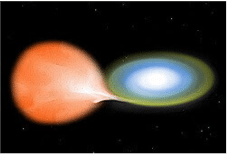
Supernova
- A supernova is the explosive death of a star and often results in the star obtaining the brightness of 100 million suns for a short time.
- The extremely luminous burst of radiation expels much or all of a star’s material at a great velocity, driving a shock wave into the surrounding interstellar medium.
- These shock waves trigger condensation is a nebula paving the way for the birth of a new star ― if a star has to be born, a star has to die!
- A great proportion of primary cosmic rays comes from supernovae.
Supernovae can be triggered in one of two ways:
- Type I supernova or Type Ia supernova (read as one-a)
(i) Occurs when there is a sudden re-ignition of nuclear fusion on the surface of a degenerate white dwarf in a binary system.
(ii) A degenerate white dwarf may accumulate sufficient material from a companion star to raise its core temperature, ignite carbon fusion, and trigger runaway nuclear fusion, completely disrupting the star.
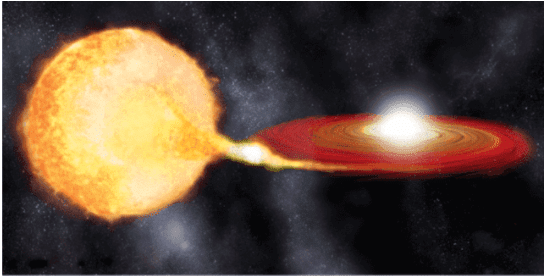
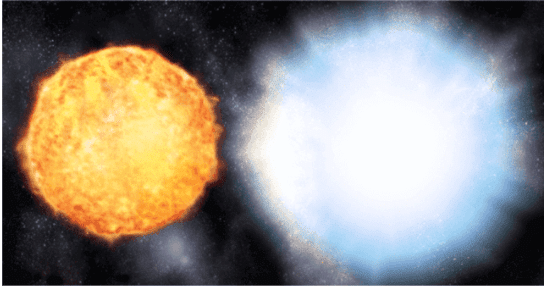
The difference between Nova and Type I supernova
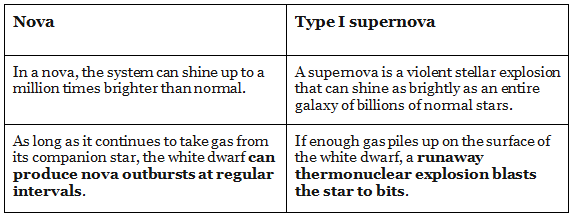
Type II supernova
- Type II supernova is a supernova that occurs by the gravitational collapse of the core of a massive star (mostly made of iron). E.g. Supernova of a red supergiant.
Importance of supernova: Creating and dispersing new elements
- When a star’s core runs out of hydrogen, the star begins to die out. The dying star expands into a red giant, and this now begins to manufacture carbon by fusing helium atoms.
- More massive stars begin a further series of nuclear burning. The elements formed in these stages range from oxygen through to iron.
- During a supernova, the star releases very large amounts of energy as well as neutrons, which allows elements heavier than iron, such as uranium and gold, to be produced.
- In the supernova explosion, all of these elements are expelled out into space, and new stars are born out of this matter (recycling of matter in the universe!).
Black dwarf
- The last stage of stellar evolution is a black dwarf.
- A black dwarf is a white dwarf that has sufficiently cooled that it no longer emits significant heat or light.
- Because the time required for a white dwarf to reach this state is calculated to be longer than the current age of the universe (13.8 billion years), no black dwarfs are expected to exist in the universe yet.
Brown Dwarfs
- Brown dwarfs are objects which are too large to be called planets and too small to be stars.
- Brown dwarfs are thought to form in the same way that stars do – from a collapsing cloud of gas and dust.
- However, as the cloud collapses, the core is not dense enough to trigger nuclear fusion.
Neutron stars
- These stars are composed mainly of neutrons and are produced after a supernova, forcing the protons and electrons to combine to produce a neutron star.
- Neutron stars are very dense. (mass of three times the Sun can be fit in a sphere of just 20km in diameter).
- If its mass is any greater, its gravity will be so strong that it will shrink further to become a black hole.
Black holes
- Black holes are believed to form from massive stars at the end of their lifetimes.
- The gravitational pull in a black hole is so great that nothing can escape from it, not even light.
- The density of matter in a black hole cannot be measured (infinite!).
- Black holes distort the space around them and can suck neighbouring matter into them including stars.
- Gravitational lensing: Light around a massive object, such as a black hole, is bent, causing it to act as a lens for the things that lie behind it.
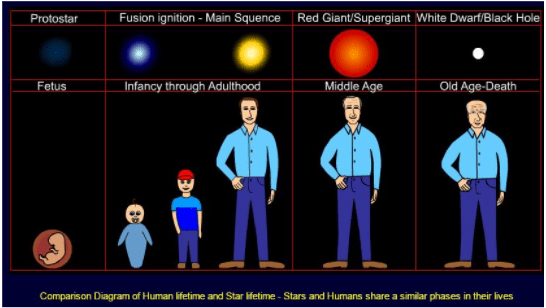
Galaxy
- Galaxy is a system of millions or billions of stars, together with gas and dust, held together by gravitational attraction. They are the major building blocks of the universe.
- The smallest galaxies contain about 100,000 stars, while the largest contains up to 3000 billion stars.

From the billions of galaxies, two basic types have been identified:
- Regular galaxies, and I
- rregular galaxies.
Regular Galaxies
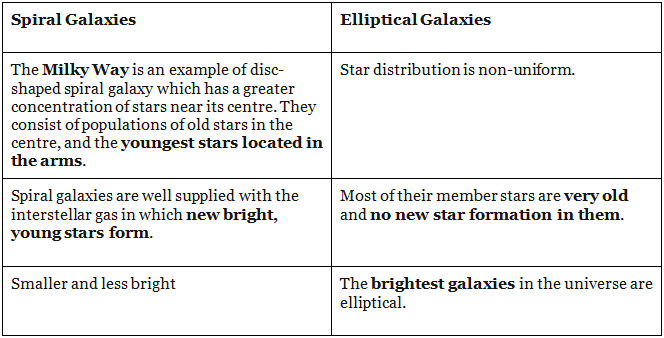
Irregular Galaxies
- The irregular galaxies comprise about one-tenth of all galaxies.
- The stars of the irregular galaxies are generally very old.
Our Galaxy (the Milky Way)
- The Milky Way is the galaxy that hosts our solar system. It is shaped like a flat disc with a central bulge.
- Its diameter is between 1,50,000 and 2,00,000 light-years.
- In the nucleus, the thickness reaches 10,000 light-years, whereas in the disc it is 500-2,000 light-years thick.
- It is estimated to contain 100-400 billion stars.
- The inner stars travel faster than those further out.
- The Solar System is located in the Orion Arm, 26,000 light-years from the center (about one-third from the center) of the Milky Way galaxy.
- The Sun completes one lap of the galaxy in about every 220 million years.
- The solar system revolves around the Milky Way with a speed of 285 km per second.
- The Andromeda Galaxy is the closest galaxy (spiral) to us – being 2 million light-years away.
Aryabhatta Research Institute of Observational Sciences (ARIES) is an autonomous institute of the Department of Science & Technology (DST).
ARIES telescope
- ARIES telescope is a joint collaboration between Indian, Russian, and Belgian scientists.
- The telescope is located at Devasthal, Nainital at a height of 2,500 meters
- The high-end technology incorporated in the telescope enables it to be operated with the help of remote control from anywhere in the world
- The telescope will be used in the study and exploration of planets, stars, magnetic field, and astronomical debris
- The scientists will also help in the research of the structures of stars and magnetic field structures of stars.
|
399 videos|751 docs|149 tests
|
FAQs on Star Formation & Galaxies - General Awareness - Bank Exams
| 1. What is star formation in galaxies? |  |
| 2. How does star formation occur in galaxies? |  |
| 3. What factors influence star formation in galaxies? |  |
| 4. What is the role of feedback mechanisms in star formation within galaxies? |  |
| 5. How does the rate of star formation vary among different types of galaxies? |  |

















